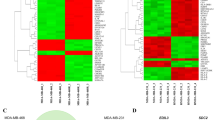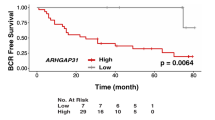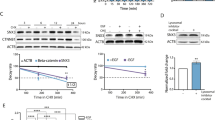Abstract
Upregulation of epidermal growth factor receptor (EGFR) and subsequent increases in extracellular-regulated kinase (ERK) and Akt signaling are implicated in prostate cancer progression. Impaired endocytic downregulation of EGFR also contributes to oncogenic phenotypes such as metastasis. Thus, understanding the roles of divergent signaling pathways in the regulation of EGFR trafficking and EGFR-driven invasive migration may enable the development of more effective therapies. In this study, we use the human prostate cancer cell lines, DU145 and PC3, to investigate the effects of both the ERK and Akt pathways on epidermal growth factor (EGF)-mediated EGFR signaling, trafficking and cell motility. We show that DU145 and PC3 cells overexpress EGFR and migrate in a ligand (EGF)-dependent manner. Next, we show that pharmacological inhibition of ERK (but not Akt) signaling enhances EGF-induced EGFR activation, ubiquitination and downregulation, and may lead to enhanced receptor turnover. These findings negatively correlate with ERK-mediated threonine phosphorylation of EGFR, implicating it as a possible mechanism. Further, we uncover that EGF promotes disassembly of cell–cell junctions, downregulation of E-cadherin and upregulation of the transcriptional repressor, Snail, typical characteristics of epithelial–mesenchymal transition (EMT). These effects are dependent on activation of Akt, as inhibition of Akt signaling abolishes EGF/EGFR-driven cell migration and EMT. Knockdown of endogenous Snail also prevents EGFR-mediated downregulation of E-cadherin, EMT and cell migration. Surprisingly, inhibition of the ERK pathway augments EGFR-dependent motility, occurring concomitantly with elevation of EGF-induced Akt activity. Collectively, our results suggest that EGF-triggered ERK activation has profound feedback on EGFR signaling and trafficking by EGFR threonine phosphorylation, and Akt has a pivotal role in EGFR-mediated cell migration by activating EMT. More important, our results also suggest that therapeutic targeting of ERK signaling may have undesirable outcomes (for example, augmenting EGFR-driven motility).
This is a preview of subscription content, access via your institution
Access options
Subscribe to this journal
Receive 50 print issues and online access
$259.00 per year
only $5.18 per issue
Buy this article
- Purchase on Springer Link
- Instant access to full article PDF
Prices may be subject to local taxes which are calculated during checkout








Similar content being viewed by others
References
Batlle E, Sancho E, Francí C, Domínguez D, Monfar M, Baulida J et al. (2000). The transcription factor snail is a repressor of E-cadherin gene expression in epithelial tumour cells. Nat Cell Biol 2: 84–89.
Cano A, Pérez-Moreno MA, Rodrigo I, Locascio A, Blanco MJ, del Barrio MG et al. (2000). The transcription factor snail controls epithelial-mesenchymal transitions by repressing E-cadherin expression. Nat Cell Biol 2: 76–83.
Cavallaro U, Christofori G . (2004). Cell adhesion and signalling by cadherins and Ig-CAMs in cancer. Nat Rev Cancer 4: 118–132.
Citri A, Yarden Y . (2006). EGF-ERBB signalling: towards the systems level. Nat Rev Mol Cell Biol 7: 505–516.
Conacci-Sorrell M, Simcha I, Ben-Yedidia T, Blechman J, Savagner P, Ben-Ze'ev A . (2003). Autoregulation of E-cadherin expression by cadherin-cadherin interactions: the roles of beta-catenin signaling, Slug, and MAPK. J Cell Biol 163: 847–857.
Davies MA, Kim SJ, Parikh NU, Dong Z, Bucana CD, Gallick GE . (2002). Adenoviral-mediated expression of MMAC/PTEN inhibits proliferation and metastasis of human prostate cancer cells. Clin Cancer Res 8: 1904–1914.
Deng L, He K, Wang X, Yang N, Thangavel C, Jiang J et al. (2007). Determinants of growth hormone receptor down-regulation. Mol Endocrinol 21: 1537–1551.
Grandal MV, Madshus IH . (2008). Epidermal growth factor receptor and cancer: control of oncogenic signalling by endocytosis. J Cell Mol Med 12: 1527–1534.
Grant S, Qiao L, Dent P . (2002). Roles of ErbB family receptor tyrosine kinases, and downstream signaling pathways, in the control of cell growth and survival. Front Biosci 7: d376–d389.
Hemavathy K, Ashraf SI, Ip YT . (2000). Snail/slug family of repressors: slowly going into the fast lane of development and cancer. Gene 257: 1–2.
Hipp S, Walch A, Schuster T, Losko S, Laux H, Bolton T et al. (2010). Activation of epidermal growth factor receptor results in Snail protein but not mRNA over-expression in endometrial cancer. J Cell Mol Med 13 (9B): 3858–3867.
Huang Y, Chang Y, Wang X, Jiang J, Frank SJ . (2004). Growth hormone alters epidermal growth factor receptor binding affinity via activation of ERKs in 3T3-F442A cells. Endocrinology 145: 3297–3306.
Huang Y, Kim SO, Jiang J, Frank SJ . (2003). Growth hormone-induced phosphorylation of epidermal growth factor (EGF) receptor in 3T3-F442A cells. Modulation of EGF-induced trafficking and signaling. J Biol Chem 278: 18902–18913.
Huang Y, Li X, Jiang J, Frank SJ . (2006). Prolactin modulates phosphorylation, signaling and trafficking of epidermal growth factor receptor in human T47D breast cancer cells. Oncogene 25: 7565–7576.
Joazeiro CA, Wing SS, Huang H, Leverson JD, Hunter T, Liu YC . (1999). The tyrosine kinase negative regulator c-Cbl as a RING-type, E2-dependent ubiquitin-protein ligase. Science 286: 309–312.
Kambhampati S, Ray G, Sengupta K, Reddy VP, Banerjee SK, Van Veldhuizen PJ . (2005). Growth factors involved in prostate carcinogenesis. Front Biosci 10: 1355–1367.
Lee MY, Chou CY, Tang MJ, Shen MR . (2008). Epithelial-mesenchymal transition in cervical cancer: correlation with tumor progression, epidermal growth factor receptor overexpression, and snail up-regulation. Clin Cancer Res 14: 4743–4750.
Levkowitz G, Waterman H, Ettenberg SA, Katz M, Tsygankov AY, Alroy I et al. (1999). Ubiquitin ligase activity and tyrosine phosphorylation underlie suppression of growth factor signaling by c-Cbl/Sli-1. Mol Cell 4: 1029–1040.
Levkowitz G, Waterman H, Zamir E, Kam Z, Oved S, Langdon WY et al. (1998). c-Cbl/Sli-1 regulates endocytic sorting and ubiquitination of the epidermal growth factor receptor. Genes Dev 12: 3663–3674.
Li X, Huang Y, Jiang J, Frank SJ . (2008). ERK-dependent threonine phosphorylation of EGF receptor modulates receptor downregulation and signaling. Cell Signal 20: 2145–2155.
Lo HW, Hsu SC, Xia W, Cao X, Shih JY, Wei Y et al. (2007). Epidermal growth factor receptor cooperates with signal transducer and activator of transcription 3 to induce epithelial-mesenchymal transition in cancer cells via up-regulation of TWIST gene expression. Cancer Res 67: 9066–9076.
Lu Z, Ghosh S, Wang Z, Hunter T . (2003). Downregulation of caveolin-1 function by EGF leads to the loss of E-cadherin, increased transcriptional activity of beta-catenin, and enhanced tumor cell invasion. Cancer Cell 4: 499–515.
Ma F, Zhang D, Yang H, Sun H, Wu W, Gan Y et al. (2009). Endothelial cell-specific molecule 2 (ECSM2) modulates actin remodeling and epidermal growth factor receptor signaling. Genes Cells 14: 281–293.
Martin GS . (2003). Cell signaling and cancer. Cancer Cell 4: 167–174.
Mendelsohn J, Baselga J . (2003). Status of epidermal growth factor receptor antagonists in the biology and treatment of cancer. J Clin Oncol 21: 2787–2799.
Moreno-Bueno G, Portillo F, Cano A . (2008). Transcriptional regulation of cell polarity in EMT and cancer. Oncogene 27: 6958–6969.
Peinado H, Olmeda D, Cano A . (2007). Snail, Zeb and bHLH factors in tumour progression: an alliance against the epithelial phenotype? Nat Rev Cancer 7: 415–428.
Qiao M, Sheng S, Pardee AB . (2008). Metastasis and AKT activation. Cell Cycle 7: 2991–2996.
Roepstorff K, Grøvdal L, Grandal M, Lerdrup M, van Deurs B . (2008). Endocytic downregulation of ErbB receptors: mechanisms and relevance in cancer. Histochem Cell Biol 129: 563–578.
Rojas M, Yao S, Lin YZ . (1996). Controlling epidermal growth factor (EGF)-stimulated Ras activation in intact cells by a cell-permeable peptide mimicking phosphorylated EGF receptor. J Biol Chem 271: 27456–27461.
Schlessinger K, Hall A . (2004). GSK-3beta sets Snail's pace. Nat Cell Biol 6: 913–915.
Sebastian S, Settleman J, Reshkin S, Azzariti A, Bellizzi A, Paradiso A . (2006). The complexity of targeting EGFR signalling in cancer: from expression to turnover. Biochim Biophys Acta 1766: 120–139.
Thiery JP . (2002). Epithelial-mesenchymal transitions in tumour progression. Nat Rev Cancer 2: 442–454.
Thiery JP, Sleeman JP . (2006). Complex networks orchestrate epithelial-mesenchymal transitions. Nat Rev Mol Cell Biol 7: 131–142.
Traish AM, Morgentaler A . (2009). Epidermal growth factor receptor expression escapes androgen regulation in prostate cancer: a potential molecular switch for tumour growth. Br J Cancer 101: 1949–1956.
Tu Y, Huang Y, Zhang Y, Hua Y, Wu C . (2001). A new focal adhesion protein that interacts with integrin-linked kinase and regulates cell adhesion and spreading. J Cell Biol 153: 585–598.
Umbas R, Isaacs WB, Bringuier PP, Schaafsma HE, Karthaus HF, Oosterhof GO et al. (1994). Decreased E-cadherin expression is associated with poor prognosis in patients with prostate cancer. Cancer Res 54: 3929–3933.
Umbas R, Schalken JA, Aalders TW, Carter BS, Karthaus HF, Schaafsma HE et al. (1992). Expression of the cellular adhesion molecule E-cadherin is reduced or absent in high-grade prostate cancer. Cancer Res 52: 5104–5109.
van Bokhoven A, Varella-Garcia M, Korch C, Johannes WU, Smith EE, Miller HL et al. (2003). Molecular characterization of human prostate carcinoma cell lines. Prostate 57: 205–225.
Waterman H, Katz M, Rubin C, Shtiegman K, Lavi S, Elson A et al. (2002). A mutant EGF-receptor defective in ubiquitylation and endocytosis unveils a role for Grb2 in negative signaling. EMBO J 21: 303–313.
Waterman H, Levkowitz G, Alroy I, Yarden Y . (1999). The RING finger of c-Cbl mediates desensitization of the epidermal growth factor receptor. J Biol Chem 274: 22151–22154.
Wells A . (1999). EGF receptor. Intl J Biochem Cell Biol 31: 637–643.
Wiley HS . (2003). Trafficking of the ErbB receptors and its influence on signaling. Exp Cell Res 284: 78–88.
Wu Y, Deng J, Rychahou PG, Qiu S, Evers BM, Zhou BP . (2009). Stabilization of snail by NF-kappaB is required for inflammation-induced cell migration and invasion. Cancer Cell 15: 416–428.
Yang CC, Wolf DA . (2009). Inflamed snail speeds metastasis. Cancer Cell 15: 355–357.
Yarden Y, Sliwkowski MX . (2001). Untangling the ErbB signalling network. Nat Rev Mol Cell Biol 2: 127–137.
Zhang Y, Chen K, Guo L, Wu C . (2002). Characterization of PINCH-2, a new focal adhesion protein that regulates the PINCH-1-ILK interaction, cell spreading, and migration. J Biol Chem 277: 38328–38338.
Zhou BP, Deng J, Xia W, Xu J, Li YM, Gunduz M et al. (2004). Dual regulation of Snail by GSK-3beta-mediated phosphorylation in control of epithelial-mesenchymal transition. Nat Cell Biol 6: 931–940.
Acknowledgements
We thank Prof. Michael Croft for generously providing retroviral expression vector for constitutively active (myristoylated) Akt. This work was supported by a St Joseph's Foundation Startup Fund (to YH). Part of this work was presented at the 91st Endocrine Society Annual Meeting in Washington DC, USA, 2009.
Author information
Authors and Affiliations
Corresponding author
Ethics declarations
Competing interests
The authors declare no conflict of interest.
Additional information
Supplementary Information accompanies the paper on the Oncogene website
Supplementary information
Rights and permissions
About this article
Cite this article
Gan, Y., Shi, C., Inge, L. et al. Differential roles of ERK and Akt pathways in regulation of EGFR-mediated signaling and motility in prostate cancer cells. Oncogene 29, 4947–4958 (2010). https://doi.org/10.1038/onc.2010.240
Received:
Revised:
Accepted:
Published:
Issue Date:
DOI: https://doi.org/10.1038/onc.2010.240
Keywords
This article is cited by
-
Exogenous growth hormone promotes an epithelial-mesenchymal hybrid phenotype in cancerous HeLa cells but not in non-cancerous HEK293 cells
Molecular and Cellular Biochemistry (2023)
-
Reduced expression of FRG1 facilitates breast cancer progression via GM-CSF/MEK-ERK axis by abating FRG1 mediated transcriptional repression of GM-CSF
Cell Death Discovery (2022)
-
miR-541-3p enhances the radiosensitivity of prostate cancer cells by inhibiting HSP27 expression and downregulating β-catenin
Cell Death Discovery (2021)
-
Rap2B knockdown suppresses malignant progression of hepatocellular carcinoma by inactivating the PTEN/PI3K/Akt and ERK1/2 pathways
Molecular and Cellular Biochemistry (2020)
-
β-Catenin nuclear localization positively feeds back on EGF/EGFR-attenuated AJAP1 expression in breast cancer
Journal of Experimental & Clinical Cancer Research (2019)



